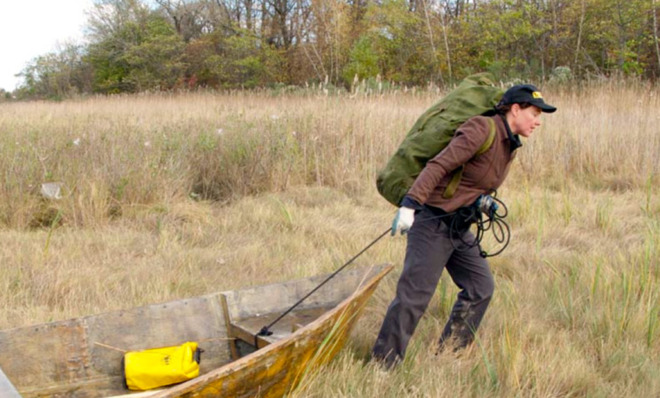Journey to the heart of a landfill
A quest to comprehend the immensity of New York City's waste


Salty mud, punctuated by plastic bottles and an oily sheen, sucked at our feet as Marie Lorenz and I walked her rowboat down to the Arthur Kill, a tidal straight separating Staten Island from Jersey. In front of us, about 50 feet from shore, sat the wrecked bodies of a dozen boats dropped in this inlet for metal salvaging in the 1950s. Just beyond them, on the western edge of Staten Island, rose the gentle slopes of Freshkills — their roundness built not by glacial rifts or tectonic plates but by man. The site was once home to the largest landfill in the country, which closed in 2001 after receiving New York City's trash for more than 50 years.
I'm a bit of a Freshkills junkie. I've read countless articles about "the fill" — probably the world's most high-profile landfill — perused old maps and project proposals, even trudged through Robert Moses' bid to turn the then-small, by comparison, Fresh Kills dump into a park in 1951. Despite all my research, I felt that somehow I had not gotten to the heart of the matter. After half a decade of writing about art and infrastructure abroad, Freshkills had caught my attention as soon as I moved to New York in 2009. What did half a century of New-York-City-scale consumption look like? And what is Freshkills today: a nature preserve, a social sculpture, a toxic wasteland — perhaps all three?
A week had passed since Hurricane Sandy struck and, through all the never-ending news reports, I had heard nothing of the landfill. On the city's zoned evacuation map, much of Staten Island's coastline, Freshkills included, had been coded red. Had the infrastructure held up? Had Sandy peeled back the layers of soil, clay, gravel, and plastic the city had laid atop our trash in an effort to hide just how much we had thrown away? Lorenz, a Brooklyn-based conceptual artist, and I had been planning to boat into the fill for a while, but checking in on it now, after the hundred-year-storm that it had been specifically engineered to withstand, lent our expedition an added air of urgency.
The Week
Escape your echo chamber. Get the facts behind the news, plus analysis from multiple perspectives.

Sign up for The Week's Free Newsletters
From our morning news briefing to a weekly Good News Newsletter, get the best of The Week delivered directly to your inbox.
From our morning news briefing to a weekly Good News Newsletter, get the best of The Week delivered directly to your inbox.
(More from Narratively: The view from the top)
I'd run into Lorenz about six months earlier at the Frieze art fair on Randall's Island where she was mounting an installation from her ongoing project "Tide and Current Taxi," which she launched in 2005. A participatory experiment of sorts, the "taxi" is a rowboat Lorenz built almost entirely from discarded packing crates. The boat is light enough for her to carry on her own, fashioned almost entirely from eighth-inch plywood, and covered in slender black lines applied through silk screening. It makes about ten excursions per year, taking self-selecting passengers wherever they want to go as long as the trip fits the boat's annual theme, which in the past has ranged from "long journeys" to "tidal cycles." She decides on the themes herself and for the most part the excursions are her artwork. However, Lorenz does occasionally make prints that reference where she has been and what her boat has come in contact with. Over the years, the sprightly Lorenz has taken people on circumnavigations of Long Island, and journeyed up the Hutchison River in the Bronx. Initially, I had wanted only to pick her brain about whether the city's Sanitation Department facilitated New York artists' increasing appetite for garbage as a material resource. But then I found out Lorenz's "Tide and Current Taxi" theme for 2012: trash. Finally, I would have the opportunity to venture into the bowels of the fill. Lorenz and I hatched a semi-illegal plan to explore Freshkills together.

Over the next 30 years, New York's Sanitation and Parks Departments, along with Field Operations (the landscape architects responsible for the High Line) will convert Freshkills into a recreation area three times the size of Central Park. The transformation, a decade after the fill's closing, is already underway to convert these heaps of used, and, perhaps most importantly, valueless materials into the second largest park in New York City. (Only Pelham Bay Park in the Bronx is bigger.). A tiny sliver of Freshkills Park opened recently, sporting a playground and soccer fields. Bird sanctuaries, bike paths, boardwalks, composting toilets, trails, bioswales (drainage courses that remove pollution from runoff water), solar panels, and native species are all to follow.
(More from Narratively: Water from above)
A free daily email with the biggest news stories of the day – and the best features from TheWeek.com
Freshkills, which began its life as a salt marsh, has countless water-to-waste-to-wonderment predecessors across the city. Queens' marshlands, which at the turn of the 20th century were the repository for the ashes of the city's thousands of coal burning furnaces, became, as if by magic, the World's Fair Grounds in 1939; and the coastal runways at LaGuardia were made by carting smoldering heaps of trash from Rikers Island (itself expanded by the city through active dumping on its way to housing the now famous prison complex) to the edge of the land, packing it down and paving it over. Throughout the 18th and 19th centuries, as trade and population grew in New York, many of the marshlands and ponds vital to the city's initial founding were filled with the detritus of industrialization — coal, brick, dead farm animals, human waste — first turning ugly, then transforming, through human intervention, into something else entirely.
And yet, something about Freshkills is different. Once the largest man-made structure in the world at just over 2,200 acres, the landfill's scale, and the half-century of consternation over the other boroughs' flagrant offloading of garbage on Staten Island, set Freshkills apart. But more than the size and stature of this particular trash heap, I imagine it is we, the inhabitants of New York, who are the greatest differentiators. Our relationship to trash has changed dramatically over the past 200 years. The British cultural anthropologist Mary Douglas, and many after her, argued that the removal of sewage and trash created the modern city — that the New Yorkers of today are defined by the disappearance of our waste.
(More from Narratively: Vinyl voyagers)
So, in the blue light of dawn on a Sunday in early November 2012, six days after Sandy made landfall in New York, Lorenz and I paddled out among the maws and ribs of rusted boats, trees sprouted on their decks, with worn plastic bags decorating their limbs. The boat was sturdy and the morning still. Lorenz, her wavy chestnut hair tucked up under a cap, her wind-blown skin a little like parchment, and her hands safely stashed away in rubber-palmed gardening gloves, had been this far before. She'd explored the Arthur Kill Boat Graveyard during a recent summer devoted to inaccessible places. As I looked back at her — chuckling as she recalled getting disastrously stuck in these very same mud flats — I wondered if exploring New York had made her perpetually young. There was something so unabashed about her curiosity. As the sun rose, we angled north toward the fill. As long as we kept to the waterways, our trip would remain perfectly kosher. Just offshore, surrounding the entire West Mound of Freshkills, was a 12-foot-high barrier fence meant to catch all the trash that somehow migrates from the dump into the sea. But with Hurricane Sandy, a new high-water mark had been set, and this time the trash flowed in instead of out. Orange catchment buoys were stranded atop the fence. Bits of trash clung to the feathered tops of the invasive marsh weeds, all bent inland from the rush of the surge.
In New York City, trash's great disappearing act creates a clean stage on which we can perfect the art of perpetual reinvention. We recycle, reuse, compost, and convert in a city relatively free from refuse. Not that New York is sparkling clean, but we have come a long way since sewage flowed in the streets, cholera ran rampant, ash piled up on every street corner, and dead fish floated down the Hudson.
Read the rest of this story at Narratively.
Narratively is an online magazine devoted to original, in-depth and untold stories. Each week,Narratively explores a different theme and publishes just one story a day. It was one of TIME's 50 Best Websites of 2013.
-
 A running list of the international figures Donald Trump has pardoned
A running list of the international figures Donald Trump has pardonedin depth The president has grown bolder in flexing executive clemency powers beyond national borders
-
 Mixed nuts: RFK Jr.’s new nutrition guidelines receive uneven reviews
Mixed nuts: RFK Jr.’s new nutrition guidelines receive uneven reviewsTalking Points The guidelines emphasize red meat and full-fat dairy
-
 Will regulators put a stop to Grok’s deepfake porn images of real people?
Will regulators put a stop to Grok’s deepfake porn images of real people?Today’s Big Question Users command AI chatbot to undress pictures of women and children